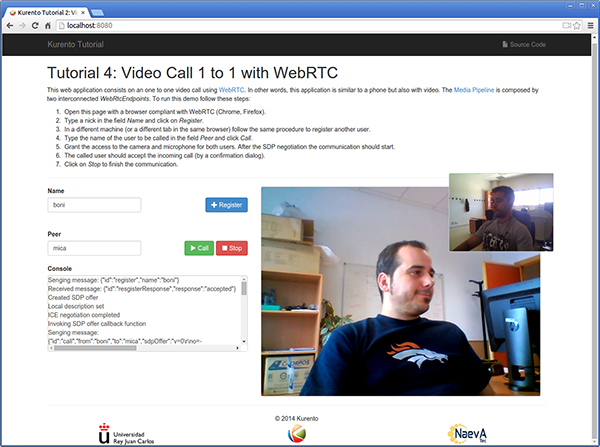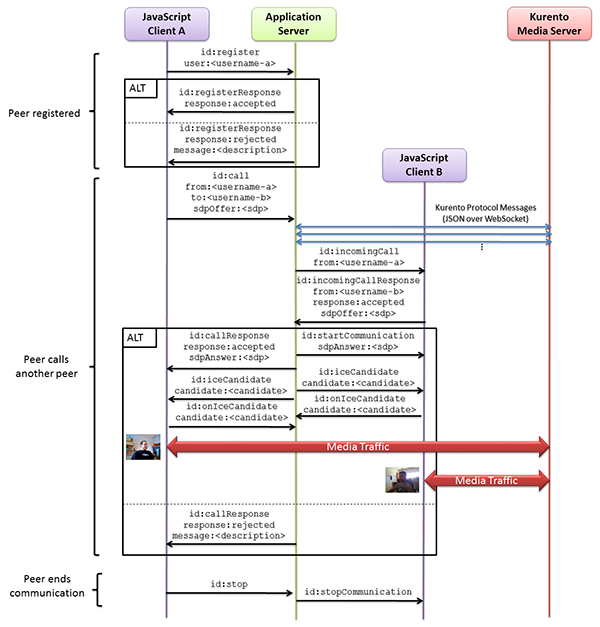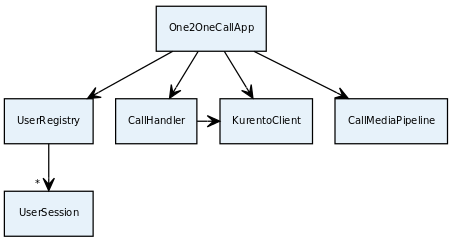Java - One to one video call
This web application consists of a one-to-one video call using WebRTC technology. In other words, this application provides a simple video softphone.
Note
Web browsers require using HTTPS to enable WebRTC, so the web server must use SSL and a certificate file. For instructions, check Configure a Java server to use HTTPS.
For convenience, this tutorial already provides dummy self-signed certificates (which will cause a security warning in the browser).
For the impatient: running this example
First of all, you should install Kurento Media Server to run this demo. Please visit the installation guide for further information.
To launch the application, you need to clone the GitHub project where this demo is hosted, and then run the main class:
git clone https://github.com/Kurento/kurento.git
cd kurento/tutorials/java/one2one-call/
git checkout 7.0.0
mvn -U clean spring-boot:run
The web application starts on port 8443 in the localhost by default. Therefore, open the URL https://localhost:8443/ in a WebRTC compliant browser (Chrome, Firefox).
Note
These instructions work only if Kurento Media Server is up and running in the same machine
as the tutorial. However, it is possible to connect to a remote KMS in other machine, simply adding
the flag kms.url to the JVM executing the demo. As we’ll be using maven, you should execute
the following command
mvn -U clean spring-boot:run \
-Dspring-boot.run.jvmArguments="-Dkms.url=ws://{KMS_HOST}:8888/kurento"
Understanding this example
The following picture shows a screenshot of this demo running in a web browser:

One to one video call screenshot
The interface of the application (an HTML web page) is composed by two HTML5 video tags: one for the local stream and other for the remote peer stream). If two users, A and B, are using the application, the media flow goes this way: The video camera stream of user A is sent to the Kurento Media Server, which sends it to user B. In the same way, B sends to Kurento Media Server, which forwards it to A. This means that KMS is providing a B2B (back-to-back) call service.
To implement this behavior, create sa Media Pipeline composed by two WebRtC endpoints connected in B2B. The implemented media pipeline is illustrated in the following picture:

One to one video call Media Pipeline
The client and the server communicate through a signaling protocol based on JSON messages over WebSocket ‘s. The normal sequence between client and server would be as follows:
User A is registered in the server with his name
User B is registered in the server with her name
User A wants to call to User B
User B accepts the incoming call
The communication is established and media is flowing between User A and User B
One of the users finishes the video communication
The detailed message flow in a call are shown in the picture below:

One to many one call signaling protocol
As you can see in the diagram, SDP and ICE candidates need to be interchanged between client and server to establish the WebRTC connection between the Kurento client and server. Specifically, the SDP negotiation connects the WebRtcPeer in the browser with the WebRtcEndpoint in the server.
The following sections describe in detail the server-side, the client-side, and how to run the demo. The complete source code of this demo can be found in GitHub.
Application Server Logic
This demo has been developed using Java in the server-side, based on the Spring Boot framework, which embeds a Tomcat web server within the generated maven artifact, and thus simplifies the development and deployment process.
Note
You can use whatever Java server side technology you prefer to build web applications with Kurento. For example, a pure Java EE application, SIP Servlets, Play, Vert.x, etc. We have choose Spring Boot for convenience.
In the following figure you can see a class diagram of the server side code:

Server-side class diagram of the one to one video call app
The main class of this demo is named
One2OneCallApp.
As you can see, the KurentoClient is instantiated in this class as a Spring
Bean.
@EnableWebSocket
@SpringBootApplication
public class One2OneCallApp implements WebSocketConfigurer {
@Bean
public CallHandler callHandler() {
return new CallHandler();
}
@Bean
public UserRegistry registry() {
return new UserRegistry();
}
@Bean
public KurentoClient kurentoClient() {
return KurentoClient.create();
}
public void registerWebSocketHandlers(WebSocketHandlerRegistry registry) {
registry.addHandler(callHandler(), "/call");
}
public static void main(String[] args) throws Exception {
new SpringApplication(One2OneCallApp.class).run(args);
}
}
This web application follows a Single Page Application architecture
(SPA), and uses a WebSocket to communicate client with server
by means of requests and responses. Specifically, the main app class implements
the interface WebSocketConfigurer to register a WebSocketHandler to
process WebSocket requests in the path /call.
CallHandler
class implements TextWebSocketHandler to handle text WebSocket requests.
The central piece of this class is the method handleTextMessage. This
method implements the actions for requests, returning responses through the
WebSocket. In other words, it implements the server part of the signaling
protocol depicted in the previous sequence diagram.
In the designed protocol there are five different kind of incoming messages to
the application server: register, call, incomingCallResponse,
onIceCandidate and stop. These messages are treated in the switch
clause, taking the proper steps in each case.
public class CallHandler extends TextWebSocketHandler {
private static final Logger log = LoggerFactory.getLogger(CallHandler.class);
private static final Gson gson = new GsonBuilder().create();
private final ConcurrentHashMap<String, CallMediaPipeline> pipelines = new ConcurrentHashMap<String, CallMediaPipeline>();
@Autowired
private KurentoClient kurento;
@Autowired
private UserRegistry registry;
@Override
public void handleTextMessage(WebSocketSession session, TextMessage message) throws Exception {
JsonObject jsonMessage = gson.fromJson(message.getPayload(), JsonObject.class);
UserSession user = registry.getBySession(session);
if (user != null) {
log.debug("Incoming message from user '{}': {}", user.getName(), jsonMessage);
} else {
log.debug("Incoming message from new user: {}", jsonMessage);
}
switch (jsonMessage.get("id").getAsString()) {
case "register":
try {
register(session, jsonMessage);
} catch (Throwable t) {
handleErrorResponse(t, session, "registerResponse");
}
break;
case "call":
try {
call(user, jsonMessage);
} catch (Throwable t) {
handleErrorResponse(t, session, "callResponse");
}
break;
case "incomingCallResponse":
incomingCallResponse(user, jsonMessage);
break;
case "onIceCandidate": {
JsonObject candidate = jsonMessage.get("candidate").getAsJsonObject();
if (user != null) {
IceCandidate cand = new IceCandidate(candidate.get("candidate").getAsString(),
candidate.get("sdpMid").getAsString(), candidate.get("sdpMLineIndex").getAsInt());
user.addCandidate(cand);
}
break;
}
case "stop":
stop(session);
break;
default:
break;
}
}
private void handleErrorResponse(Throwable t, WebSocketSession session,
String responseId) throws IOException {
stop(session);
log.error(t.getMessage(), t);
JsonObject response = new JsonObject();
response.addProperty("id", responseId);
response.addProperty("response", "rejected");
response.addProperty("message", t.getMessage());
session.sendMessage(new TextMessage(response.toString()));
}
private void register(WebSocketSession session, JsonObject jsonMessage) throws IOException {
...
}
private void call(UserSession caller, JsonObject jsonMessage) throws IOException {
...
}
private void incomingCallResponse(final UserSession callee, JsonObject jsonMessage) throws IOException {
...
}
public void stop(WebSocketSession session) throws IOException {
...
}
@Override
public void afterConnectionClosed(WebSocketSession session, CloseStatus status) throws Exception {
stop(session);
registry.removeBySession(session);
}
}
In the following snippet, we can see the register method. Basically, it
obtains the name attribute from register message and check if there are
a registered user with that name. If not, the new user is registered and an
acceptance message is sent to it.
private void register(WebSocketSession session, JsonObject jsonMessage) throws IOException {
String name = jsonMessage.getAsJsonPrimitive("name").getAsString();
UserSession caller = new UserSession(session, name);
String responseMsg = "accepted";
if (name.isEmpty()) {
responseMsg = "rejected: empty user name";
} else if (registry.exists(name)) {
responseMsg = "rejected: user '" + name + "' already registered";
} else {
registry.register(caller);
}
JsonObject response = new JsonObject();
response.addProperty("id", "resgisterResponse");
response.addProperty("response", responseMsg);
caller.sendMessage(response);
}
In the call method, the server checks if there is a registered user with the
name specified in to message attribute, and sends an incomingCall
message. If there is no user with that name, a callResponse message is sent
to caller rejecting the call.
private void call(UserSession caller, JsonObject jsonMessage) throws IOException {
String to = jsonMessage.get("to").getAsString();
String from = jsonMessage.get("from").getAsString();
JsonObject response = new JsonObject();
if (registry.exists(to)) {
UserSession callee = registry.getByName(to);
caller.setSdpOffer(jsonMessage.getAsJsonPrimitive("sdpOffer").getAsString());
caller.setCallingTo(to);
response.addProperty("id", "incomingCall");
response.addProperty("from", from);
callee.sendMessage(response);
callee.setCallingFrom(from);
} else {
response.addProperty("id", "callResponse");
response.addProperty("response", "rejected: user '" + to + "' is not registered");
caller.sendMessage(response);
}
}
The stop method ends the video call. It can be called both by caller and
callee in the communication. The result is that both peers release the Media
Pipeline and ends the video communication:
public void stop(WebSocketSession session) throws IOException {
String sessionId = session.getId();
if (pipelines.containsKey(sessionId)) {
pipelines.get(sessionId).release();
CallMediaPipeline pipeline = pipelines.remove(sessionId);
pipeline.release();
// Both users can stop the communication. A 'stopCommunication'
// message will be sent to the other peer.
UserSession stopperUser = registry.getBySession(session);
if (stopperUser != null) {
UserSession stoppedUser = (stopperUser.getCallingFrom() != null)
? registry.getByName(stopperUser.getCallingFrom())
: stopperUser.getCallingTo() != null
? registry.getByName(stopperUser.getCallingTo())
: null;
if (stoppedUser != null) {
JsonObject message = new JsonObject();
message.addProperty("id", "stopCommunication");
stoppedUser.sendMessage(message);
stoppedUser.clear();
}
stopperUser.clear();
}
}
}
In the incomingCallResponse method, if the callee user accepts the call, it
is established and the media elements are created to connect the caller with
the callee in a B2B manner. Basically, the server creates a
CallMediaPipeline object, to encapsulate the media pipeline creation and
management. Then, this object is used to negotiate media interchange with
user’s browsers.
The negotiation between WebRTC peer in the browser and WebRtcEndpoint in Kurento
Media Server is made by means of SDP generation at the client (offer)
and SDP generation at the server (answer). The SDP answers are generated with
the Kurento Java Client inside the class CallMediaPipeline (as we see in a
moment). The methods used to generate SDP are
generateSdpAnswerForCallee(calleeSdpOffer) and
generateSdpAnswerForCaller(callerSdpOffer):
private void incomingCallResponse(final UserSession callee, JsonObject jsonMessage) throws IOException {
String callResponse = jsonMessage.get("callResponse").getAsString();
String from = jsonMessage.get("from").getAsString();
final UserSession calleer = registry.getByName(from);
String to = calleer.getCallingTo();
if ("accept".equals(callResponse)) {
log.debug("Accepted call from '{}' to '{}'", from, to);
CallMediaPipeline pipeline = null;
try {
pipeline = new CallMediaPipeline(kurento);
pipelines.put(calleer.getSessionId(), pipeline);
pipelines.put(callee.getSessionId(), pipeline);
String calleeSdpOffer = jsonMessage.get("sdpOffer").getAsString();
callee.setWebRtcEndpoint(pipeline.getCalleeWebRtcEP());
pipeline.getCalleeWebRtcEP().addIceCandidateFoundListener(new EventListener<IceCandidateFoundEvent>() {
@Override
public void onEvent(IceCandidateFoundEvent event) {
JsonObject response = new JsonObject();
response.addProperty("id", "iceCandidate");
response.add("candidate", JsonUtils.toJsonObject(event.getCandidate()));
try {
synchronized (callee.getSession()) {
callee.getSession().sendMessage(new TextMessage(response.toString()));
}
} catch (IOException e) {
log.debug(e.getMessage());
}
}
});
String calleeSdpAnswer = pipeline.generateSdpAnswerForCallee(calleeSdpOffer);
String callerSdpOffer = registry.getByName(from).getSdpOffer();
calleer.setWebRtcEndpoint(pipeline.getCallerWebRtcEP());
pipeline.getCallerWebRtcEP().addIceCandidateFoundListener(new EventListener<IceCandidateFoundEvent>() {
@Override
public void onEvent(IceCandidateFoundEvent event) {
JsonObject response = new JsonObject();
response.addProperty("id", "iceCandidate");
response.add("candidate", JsonUtils.toJsonObject(event.getCandidate()));
try {
synchronized (calleer.getSession()) {
calleer.getSession().sendMessage(new TextMessage(response.toString()));
}
} catch (IOException e) {
log.debug(e.getMessage());
}
}
});
String callerSdpAnswer = pipeline.generateSdpAnswerForCaller(callerSdpOffer);
JsonObject startCommunication = new JsonObject();
startCommunication.addProperty("id", "startCommunication");
startCommunication.addProperty("sdpAnswer", calleeSdpAnswer);
synchronized (callee) {
callee.sendMessage(startCommunication);
}
pipeline.getCalleeWebRtcEP().gatherCandidates();
JsonObject response = new JsonObject();
response.addProperty("id", "callResponse");
response.addProperty("response", "accepted");
response.addProperty("sdpAnswer", callerSdpAnswer);
synchronized (calleer) {
calleer.sendMessage(response);
}
pipeline.getCallerWebRtcEP().gatherCandidates();
} catch (Throwable t) {
log.error(t.getMessage(), t);
if (pipeline != null) {
pipeline.release();
}
pipelines.remove(calleer.getSessionId());
pipelines.remove(callee.getSessionId());
JsonObject response = new JsonObject();
response.addProperty("id", "callResponse");
response.addProperty("response", "rejected");
calleer.sendMessage(response);
response = new JsonObject();
response.addProperty("id", "stopCommunication");
callee.sendMessage(response);
}
} else {
JsonObject response = new JsonObject();
response.addProperty("id", "callResponse");
response.addProperty("response", "rejected");
calleer.sendMessage(response);
}
}
The media logic in this demo is implemented in the class
CallMediaPipeline.
As you can see, the media pipeline of this demo is quite simple: two
WebRtcEndpoint elements directly interconnected. Please take note that the
WebRtcEndpoints need to be connected twice, one for each media direction.
public class CallMediaPipeline {
private MediaPipeline pipeline;
private WebRtcEndpoint callerWebRtcEP;
private WebRtcEndpoint calleeWebRtcEP;
public CallMediaPipeline(KurentoClient kurento) {
try {
this.pipeline = kurento.createMediaPipeline();
this.callerWebRtcEP = new WebRtcEndpoint.Builder(pipeline).build();
this.calleeWebRtcEP = new WebRtcEndpoint.Builder(pipeline).build();
this.callerWebRtcEP.connect(this.calleeWebRtcEP);
this.calleeWebRtcEP.connect(this.callerWebRtcEP);
} catch (Throwable t) {
if (this.pipeline != null) {
pipeline.release();
}
}
}
public String generateSdpAnswerForCaller(String sdpOffer) {
return callerWebRtcEP.processOffer(sdpOffer);
}
public String generateSdpAnswerForCallee(String sdpOffer) {
return calleeWebRtcEP.processOffer(sdpOffer);
}
public void release() {
if (pipeline != null) {
pipeline.release();
}
}
public WebRtcEndpoint getCallerWebRtcEP() {
return callerWebRtcEP;
}
public WebRtcEndpoint getCalleeWebRtcEP() {
return calleeWebRtcEP;
}
}
In this class we can see the implementation of methods
generateSdpAnswerForCaller and generateSdpAnswerForCallee. These
methods delegate to WebRtc endpoints to create the appropriate answer.
Client-Side
Let’s move now to the client-side of the application. To call the previously
created WebSocket service in the server-side, we use the JavaScript class
WebSocket. We use a specific Kurento JavaScript library called
kurento-utils.js to simplify the WebRTC interaction with the server. This
library depends on adapter.js, which is a JavaScript WebRTC utility
maintained by Google that abstracts away browser differences. Finally
jquery.js is also needed in this application.
These libraries are linked in the index.html web page, and are used in the index.js.
In the following snippet we can see the creation of the WebSocket (variable
ws) in the path /call. Then, the onmessage listener of the
WebSocket is used to implement the JSON signaling protocol in the client-side.
Notice that there are five incoming messages to client: resgisterResponse,
callResponse, incomingCall, iceCandidate and
startCommunication. Convenient actions are taken to implement each step in
the communication. For example, in functions call and incomingCall (for
caller and callee respectively), the function WebRtcPeer.WebRtcPeerSendrecv
of kurento-utils.js is used to start a WebRTC communication.
var ws = new WebSocket('ws://' + location.host + '/call');
ws.onmessage = function(message) {
var parsedMessage = JSON.parse(message.data);
console.info('Received message: ' + message.data);
switch (parsedMessage.id) {
case 'resgisterResponse':
resgisterResponse(parsedMessage);
break;
case 'callResponse':
callResponse(parsedMessage);
break;
case 'incomingCall':
incomingCall(parsedMessage);
break;
case 'startCommunication':
startCommunication(parsedMessage);
break;
case 'stopCommunication':
console.info("Communication ended by remote peer");
stop(true);
break;
case 'iceCandidate':
webRtcPeer.addIceCandidate(parsedMessage.candidate, function (error) {
if (!error) return;
console.error("Error adding candidate: " + error);
});
break;
default:
console.error('Unrecognized message', parsedMessage);
}
}
function incomingCall(message) {
//If bussy just reject without disturbing user
if (callState != NO_CALL) {
var response = {
id : 'incomingCallResponse',
from : message.from,
callResponse : 'reject',
message : 'bussy'
};
return sendMessage(response);
}
setCallState(PROCESSING_CALL);
if (confirm('User ' + message.from
+ ' is calling you. Do you accept the call?')) {
showSpinner(videoInput, videoOutput);
from = message.from;
var options = {
localVideo: videoInput,
remoteVideo: videoOutput,
onicecandidate: onIceCandidate,
onerror: onError
}
webRtcPeer = new kurentoUtils.WebRtcPeer.WebRtcPeerSendrecv(options,
function (error) {
if(error) {
return console.error(error);
}
webRtcPeer.generateOffer (onOfferIncomingCall);
});
} else {
var response = {
id : 'incomingCallResponse',
from : message.from,
callResponse : 'reject',
message : 'user declined'
};
sendMessage(response);
stop();
}
}
function call() {
if (document.getElementById('peer').value == '') {
window.alert("You must specify the peer name");
return;
}
setCallState(PROCESSING_CALL);
showSpinner(videoInput, videoOutput);
var options = {
localVideo: videoInput,
remoteVideo: videoOutput,
onicecandidate: onIceCandidate,
onerror: onError
}
webRtcPeer = new kurentoUtils.WebRtcPeer.WebRtcPeerSendrecv(options,
function (error) {
if(error) {
return console.error(error);
}
webRtcPeer.generateOffer (onOfferCall);
});
}
Dependencies
This Java Spring application is implemented using Maven. The relevant part of the pom.xml is where Kurento dependencies are declared. As the following snippet shows, we need two dependencies: the Kurento Client Java dependency (kurento-client) and the JavaScript Kurento utility library (kurento-utils) for the client-side. Other client libraries are managed with webjars:
<dependencies>
<dependency>
<groupId>org.kurento</groupId>
<artifactId>kurento-client</artifactId>
</dependency>
<dependency>
<groupId>org.kurento</groupId>
<artifactId>kurento-utils-js</artifactId>
</dependency>
<dependency>
<groupId>org.webjars</groupId>
<artifactId>webjars-locator</artifactId>
</dependency>
<dependency>
<groupId>org.webjars.bower</groupId>
<artifactId>bootstrap</artifactId>
</dependency>
<dependency>
<groupId>org.webjars.bower</groupId>
<artifactId>demo-console</artifactId>
</dependency>
<dependency>
<groupId>org.webjars.bower</groupId>
<artifactId>draggabilly</artifactId>
</dependency>
<dependency>
<groupId>org.webjars.bower</groupId>
<artifactId>adapter.js</artifactId>
</dependency>
<dependency>
<groupId>org.webjars.bower</groupId>
<artifactId>jquery</artifactId>
</dependency>
<dependency>
<groupId>org.webjars.bower</groupId>
<artifactId>ekko-lightbox</artifactId>
</dependency>
</dependencies>
Note
You can find the latest version of Kurento Java Client at Maven Central.